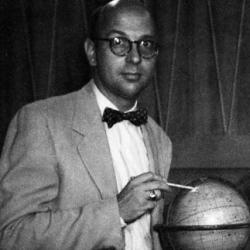 |
 |
 |
 |
 |
 |
 |
 |
 |
 |
 |
 |
|
Alumni
|
Alumni: Frank N. Jr Edmonds, 1950 Ph.D., University of Chicago, 1950 September 2, 1919 - September 3, 1986 Webpage Edmonds graduated with a BS degree in physics from Princeton University in 1941. The onset of World War II prevented his acceptance of a scholarship to attend graduate school in Toronto. He served as a Second Lieutenant in the Signal Corps of the Army Air Force for four years, working as a Ground Radar Equipment Maintenance Officer in both the European and Pacific theatres, and emerging with decorations as Captain at the end of the war. Frank Edmonds resumed his academic studies as a graduate student at the University of Chicago under two of the most renowned astrophysicists of the twentieth century, Otto Struve, who was the first director of McDonald Observatory, and Subrahmanyan Chandrasekhar, who later won a Nobel Prize. He completed his PhD dissertation, "Two Problems in Radiative Transfer Theory", in 1950. The dissertation led to a series of papers published in the Astrophysical Journal in the 1950s. Edmonds began his academic career as Assistant Professor of Astronomy at the University of Missouri, Columbia (1950-1952). With Otto Struve's high recommendation, he joined the faculty of the University of Texas at Austin as Assistant Professor of Mathematics and Astronomy (1952-1958). He joined the newly formed, separate Astronomy Department of UT as Associate Professor in 1958. He also served as Associate Chairman of the Astronomy Department, 1959 to 1961. The department was initially formed as a joint astronomy department with the University of Chicago, for UT astronomers to share in the running of McDonald Observatory. UT had received a bequest from West Texas banker W. J. McDonald in 1926 for the observatory, and partnered with the University of Chicago in 1932, but that deal had allowed for the University of Chicago to operate the observatory for 30 years. Edmonds was the only observational astronomer from UT to use McDonald Observatory for most of the 1950s, and served as its Associate Director from 1960 to 1962. During that time he played a major role in getting UT to continue the operation of the observatory after the expiration of the agreement with Chicago in 1963. Harlan J. Smith became Chairman of the Astronomy Department and Director of the Observatory at that time. From 1962 to 1963, Dr. Edmonds spent a year in France as a Guggenheim fellow at the Section d'Astrophysique of the Observatoire de Paris, Meundon. Back in Austin, he was promoted to full professor in 1965. He made significant contributions to the development of the Astronomy Department during his 32 years of service. He created the position of Graduate Advisor and Chairman of the Graduate Studies Committee in 1960, and he served in that position for over 20 years, guiding several generations of graduate students who are now internationally recognized. He created and taught numerous courses, concentrating on undergraduate and graduate courses in astronomical physics and in the astrophysics of stellar atmospheres. In addition to his teaching, he contributed a substantial body of scientific research to high-dispersion stellar spectroscopy, stellar atmospheres, solar photospheric inhomogeneities, radiative transfer theory, and astronomical physics. His work on solar granulation and his exhaustive analysis of the spectrum of Procyon are regarded as major contributions to astronomical research. |

